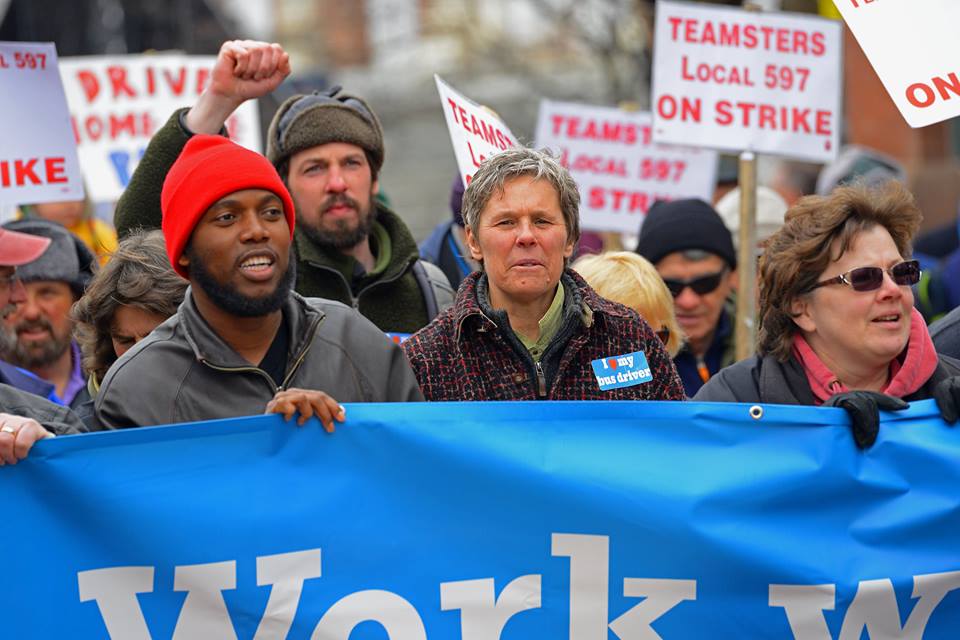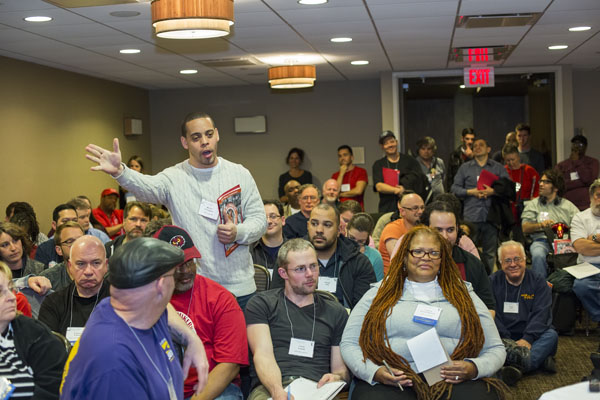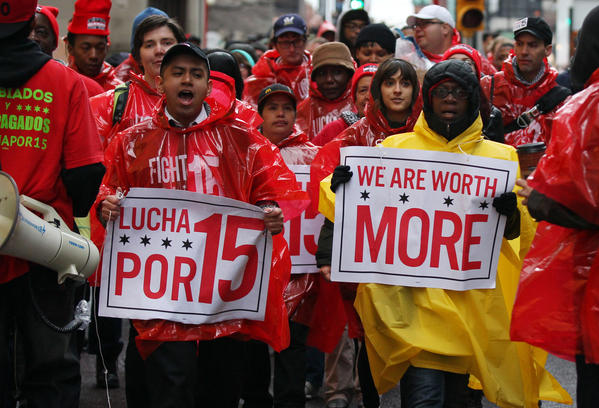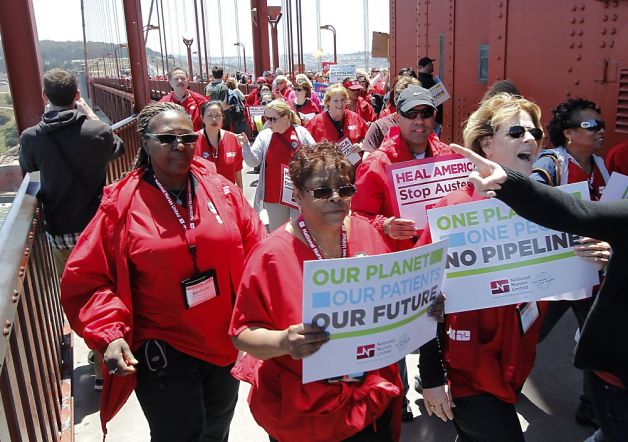Equal Time Radio interviews Kim Moody and Sheila Cohen
May 5, 2014
Labor activist/intellectual Kim Moody, author of In Solidarity: Essays on Working-Class Organization and Strategy in the United States and a founder of Labor Notes, and Sheila Cohen, author of Ramparts of Resistance: Why Workers Lost Their Power, and How to Get It Back and Notoriously Militant: The Story of a Union Branch, discuss the present state and the future possibilities of the US labor movement and the forces working against it with Nancy Welch of the University of Vermont’s United Academics and Traven Leyshon of Equal Time Radio.
They argue for the enduring importance of building workplace power, and explore links between everyday workplace struggles and movements for broader change. They contrast the growing movements for democratic, social movement unionism with bureaucratic business unionism’s failure to meet the challenges working people face. This interview first aired on Equal Time Radio in Vermont on WDEV and can be heard here. The transcription below includes some edits for readability. Sheila Cohen’s participation was limited due to phone issues encountered during the interview.
Traven Leyshon: Why don’t I just start out with a question, which some listeners may be wondering, why are we even talking about unions? Aren’t they an anachronism? Your book covers something like 48 years of writing about the labor movement. Why have you maintained that focus when so many others, including radicals, are looking elsewhere as a way to cope with the profound challenges we face?
Kim Moody: Two things. One, it’s a question of power. There are a lot of ways to protest and fight, but the question is “what has the most potential power in this type of capitalist society?” I continue to think and argue that this lies primarily in the workplace, with the working class. Yes, there are many fewer union members than there were 30 or 40 years ago, but there are still about 15 million people located in important parts of the economy. The second thing I’d say is, if unions didn’t matter, somebody explain to me why it is that the Republican Party and even the Democrats, backed by big business, are spending such an enormous amount of effort to destroy these organizations. They obviously feel that these organizations are a barrier to their neoliberal goals, to their profit maximization, and all the rest of it. So, somebody in the United States here thinks that unions are important, even if they wouldn’t want to put it that way themselves.
Nancy Welch: I’d like to come in here to say that we have just seen locally a real testament to the power and continuing significance of unions. We just saw an amazing victory with 70 bus drivers waging a three week strike with admirable unity within their ranks, but also tremendous public support, because people really saw the drivers’ issues as their issues, both in terms of dignity at work, and also in defense of public resources, also a strike against racism, and so forth. It’s an incredible example of a broader public realizing how much power even 70 bus drivers have to amplify these issues.
One of the things that I have been thinking about since that strike, because there’s such an uptick in confidence across the region among union locals and even non-unionized workers about what we can win–there’s a section in In Solidarity about the dialectic of constant struggle and it makes me wonder how do we both carry forward a victory like this, carry on this kind of class struggle unionism and struggle for union democracy, but avoid succumbing to exhaustion, which both of you have written about with the 1970s rank and file rebellion.

Vermont bus drivers struck for 18 days, declaring victory with an improved contract on April 3, 2014. (Photo: Vermont Workers Center)
KM: That’s a good question, “how do you avoid exhaustion?” Well, I can only answer that in a sort of an indirect way.
Both Shelia and I just came from a conference in Chicago, the Labor Notes conference. There were over 2,000 trade unionist activists there. These people were not exhausted. I haven’t seen that kind of energy for quite some time. Even the previous conference, which I thought was full of energy, couldn’t compare to this one in numbers and energy.
In the number of people who were rank and file workers, they were working on kicking out the old guard, taking over their locals, and remaking them to be more democratic and place more emphasis on workplace organization–where power begins–and to place more emphasis on broader issues as well. These were very inspiring people. They’re organizing not only to change their own unions, but there were these people there who are organizing to unionize, or to build some sort of workers organization, in this whole logistics complex that’s related to Walmart and warehousing and all types of intermodal transportation. There were railroad people, truck drivers, and people working in these warehouses, all of these people are organizing and they certainly haven’t reached the point of exhaustion yet and I don’t see that happening anytime soon. What I see now is more energy.
TL: There were actually some thirty Vermonters who made the trek out to Chicago to go to that conference and were pretty inspired by it. You make the case, let me put this to Sheila, that the crisis within the labor movement is not solely the result of external forces like what’s going on with the economic system, that many of labor’s wounds that are self-inflicted by the unique character of most US unions. Can you talk about this?

One of many packed workshops at the 2014 Labor Notes conference in Chicago. (Photo: Jim West)
Sheila Cohen: Yes, I think what’s interesting is that back in the mid-90s, it was actually the American trade union movement which came up with a more energetic rank and file-based organizing model. I think the results of that have not been what they could have been. I remember reading these things about it early on, which were all about worker-to-worker organizing, unionized workers going out and organizing those in the same industries, certain areas who weren’t in unions. Yet, it seems to have become very much bureaucratized, very much top-down.
TL: Let’s also ask Kim, who’s written a few books about that, this crisis in the labor movement. It’s obviously a pretty hostile political environment and has been for at least since the late 1970s, but you also make the argument that some of the weaknesses, labor’s problems, are self-inflicted.
KM: Well, yeah, I think that the problem has been what Sheila was just saying. We had this whole, for years and years it was a very conventional way of organizing new workers and that just ceased to work by the 1980s, at least, and possibly before that. The NLRB, the National Labor Relations Board, and the National Labor Relations Act no longer worked in most cases, so unions started looking for new things, and there were a lot of good ideas, a lot of good experiments. People might remember in the 1990s, the Justice for Janitors thing was very inspiring. But one of the problems is that, because American unions are so inherently top-heavy, bureaucratized, even these experiments become routinized things you do over and over again. Community support becomes rounding up the clergy to look like you have support, and so on. I’m not saying people aren’t doing better things than that, but what I’m talking about is the, particularly the SEIU model, which doesn’t seem to be really working anymore. If you look at the figures, their own growth has pretty much stopped.
So, the problem is, how do we get beyond the formalistic and bureaucratic approaches to these things and start to use, many people have proposed this such as Kate Bronfenbrenner, use the actual members themselves to do some of this organizing. As she put it, the first thing you do is not to sign an authorization card or the usual thing, but you start acting like a union even before recognition, and that you stop the separation of the fight for recognition from the fight for bargaining, which is an old, sort of traditional way that unions still do things. All of this should be one process and it needs to involve the workers themselves and others who can support them, whether that comes from other unions or the same union, and mobilization is needed, but not just, you know, on and off mobilization, but a kind of more permanent mobilization. Of course, that’s not completely possible, but involving the grassroots in these things much more than the case is now. Some unions do more of that now than they used to, and that’s all to the good. I think the UNITE HERE Hotel Workers Rising campaign sort of has that side to it, but it needs to become universal.
The other thing I think was, the big strategy for a while in the 90s and into this century was this neutrality clause tactic. Now, some of the time, that works, but some of the time it doesn’t work for the simple reason that American employers are not interested in being neutral, they’re not interested in recognizing unions. We can see over and over that they’re trying to push them out. So, it sounds like a good idea, but as we saw in the case of the UAW and Volkswagon in Tennessee, their neutrality agreement was completely violated and, in the end, the NLRB has not been able to do anything about it at all, and now apparently the UAW has even withdrawn their case on this. Let’s try the one thing that has historically worked, whether you look back to the 30s or whenever, which is mass mobilization of workers.
TL: I wonder if you see the Chicago Teachers Union strike and their ongoing work and campaigns like Fight For 15 as being a way forward out of this routinization and top-down approach.
KM: Yes, I definitely do. I think particularly the Chicago Teachers Union, the thing that’s important there is that this is something they’ve prepared for for a number of years. They didn’t just start out by running people for union office, they started out by organizing in the schools, in the workplace, building a kind of organization—a caucus, but not just a caucus—building support for their ideas over a period of time that allowed them to take over this huge local teachers’ union, one of the biggest in the country, and not just take it over, but to keep the members mobilized so that the strike was a phenomenal success, given the reality of things these days, and even with the powerful opposition to that kind of activity on the part of the City of Chicago. So, yes, I think there is a mobilization model that shows a lot of very careful organizing and educating people around the issues, drawing in the parents and the students. This was important as well.
The other thing you mentioned was the fast food workers effort for $15 an hour. Yes, there again is something that’s kind of phenomenal. I know it has backing from unions and everything, but the fact that they could pull this off in something like 100 cities at the same time, pretty much, this is phenomenal. And it had an impact. I don’t know how much in terms of winning, that may not have happened everywhere yet, but it’s definitely had an impact on the way people look at these things. Who would have ever thought you could organize these fast food workers? Well, they seem to be organizing themselves in large part, and that’s very important here.
These are two very important developments and I think, again, referring to the Labor Notes conference is helpful, because it’s such a great setting for seeing all these different things at once and the fact that they relate to each other…that we’re not just talking about this separate thing and that separate thing, people from different efforts are now looking at each other and we’re looking at something more like what you dare to call “a class mobilization” here, at least the beginnings of it, hopefully.

Workers and supporters at a “Fight For $15” action in Chicago last year. (Photo: John J. Kim, Chicago Tribune)
TL: We’ve got a caller from Barre, your thoughts?
Caller: There is one area where labor has made a mistake and I would like to see it not continue to make that mistake in the future, as we get into more and more personal service type of arrangements and as the Baby Boom generation gets into old age. I’m talking about organized labor in places where workers take care of people with disabilities. The old Vermont state hospital was a horror pit and the staff culture was such that the patients were treated as the enemy to be controlled, coerced, and there were some real awful things that went on there.
I’m hoping that the new state hospital will not be like that. The union representatives, sadly, often interfaced with the public by denouncing the patients as horrible, violent subhumans. And when the Brandon Training School, which had its history of brutality and rapes by staff on patients, was shut down, they fought that. If you have people working in facilities for “devalued” people with disabilities, to use the union to make war on the people with disabilities, as has been done, is a huge mistake. I’m really hoping that unions can get away from that and make common cause with the people that they’re caring for, to give labor a better name–and also, if you work with people, they behave better than if you treat them badly.
TL: I think this relates to the whole question of “social movement unionism” that you talk a lot about Kim, about the purpose of unions.
KM: Yes, first of all, I don’t disagree with what the questioner just asked. Obviously, you have to look first, I think though, there’s a fundamental problem we have in this country and that’s that the whole medical system, our whole healthcare system, even with Obamacare–there’s some improvements and everything–but it’s still a situation where there are essentially (even though they call themselves non-profit) profit-making institutions charged with delivering healthcare. They are short-handed, which is one of the reasons employees don’t act right. I’m not excusing the things that were just mentioned in the least, but that is a factor here.
What I would point to, agreeing with what she has just said, I point to some of the instances, particularly among nurses in the new nursing unions where their demands are precisely demands about patient care. They’re talking about nurse-to-patient ratios, because if you want better care, you’ve got to have more nurses. The hospitals, on the other hand, want fewer nurses. They want them to work harder. They’re using lean production techniques in healthcare, which should never have been the case. They’re standardizing healthcare when we know that every patient, especially when we’re talking about disabilities, that every patient is different, requires individualized care, and so forth. These unions are actually fighting on the patient’s side, so I think that’s, in terms of unionization in the growing healthcare industry, that’s definitely the way to go. I agree with that.
NW: In In Solidarity you touch on the importances of alliances with community-based organizations representing the concerns and struggles of working class people who may not be in labor unions at all. And you also mention that political and social street mobilization don’t necessarily begin as a work place mobilization but can involve and invoke the power of work stoppages. I think for me, reading In Solidarity, what becomes clear over and over again is the importance of not just unions, but a labor movement writ large, making common cause, seeing ourselves as being involved in social movement unionism, not just because then we get the support we need to win our particular strike, but because it is about reaching and organizing and uniting a working class—so that means teachers uniting with parents and students and communities of color, that means nurses uniting with patients and so forth.
But I wanted to talk a little bit more about your take on the importance of such alliances, the integration of struggles against exploitation and oppression together, and also what some of the challenges are. Not just the kind of bigger union bureaucracies, but even at the local level trying to really enact solidarity in that broad way.
KM: Yes, there is a growing periphery of types of worker organizations that are not traditional union organizations and these are important because they reach whole groups of workers, particularly immigrant workers, that the unions traditionally didn’t want to organize. Now they’ve changed their attitude and are trying to do that, but these types of organizations become important. Street mobilization, the Occupy movement, things like this are important because, to put it bluntly, if we don’t disrupt this society in our way, just as the Tea Party people disrupted it in their way, we’re not going to make progress. And that requires these broad mobilizations that you’re talking about.
I would say, and I think I say this in the essays, that when it comes down to, ultimately, the question of social power, it really falls back on the unions and that’s why more workers centers work more closely with the unions and unions in turn with them–because mobilization in the community can be crucial and important, but there isn’t the same, in most circumstances, the same level of social power there. If we’re not building a broad labor movement, it’s a mistake, but if we’re not building a labor movement that has a growing core of permanent organization in America’s workplaces, or in the workplaces of any country, we’re going to have good flashes in the pan like the Occupy movement, but a movement like that can’t be permanent. It has to fall back on some central core of power and in our society, at least now, that power generally means unions.
Hopefully, it can mean broader political things, but that’s very difficult in this country. I think, in understanding the whole idea of working class organization as coalitions, there just has to be this power in the workplace. That’s clearly what frightens the powers that be. You see this in the public sector with this absolutely fanatical attempt to break public sector unions. Because they understand, these people who want to avoid taxes and don’t like government, they understand that public sector unions are the power in the state that goes against what they want and prove to be a barrier to their neoliberal agenda. And that’s why they’re going after them, because they understand their social power. Look at the teachers union in Chicago, and something similar is bubbling up in Los Angeles as well. I think these kind of things are going to catch on. So, my take on what’s being called “social movement unionism,” is that it has to rest on the core of unions.
NW: I can definitely see that the continued power of the movement like Idle No More, to the north of us, and, in this state, the long struggle to shut down Vermont Yankee (the nuclear power plant), that these kinds of movements are greatly aided or they can be held back or hampered depending on whatever labor decides about these issues. I’m wondering, for activists working within unions and trying to organize and convince their locals or leadership beyond that we need to take up issues of the environment, LGBT rights, anti-racist work and so forth, what do we do in the face of an often recalcitrant leadership to make these alliances?

National Nurses United and environmentalists march on the Golden Gate Bridge on June 20, 2013 to protest the Keystone XL pipeline. (Photo: Michael Macor, The Chronicle)
KM: I think you actually answered your own question! The unions have to make these issues into bargaining issues and not just issues they make statements on or do lobbying on. A lot of these issues of racism, sexism, issues of sexual preference, etc., these are things that unions can do something about (and some do).
One of the things that we used to say a lot at Labor Notes is that, “in broadening the labor movement, we also want to broaden the bargaining agenda.” I found it really interesting what the Chicago Teachers Union were talking about. They said “we’re not allowed to bargain around not closing the fifty schools that the city wants to close, but we will bring it up during the bargaining session, and maybe we won’t win it right now, but it’s not just something we put out there in the streets in hopes that somebody will respond, it’s something that we’ll put on the table.” So I think that’s part of the answer.
Unions finally, after decades of not dealing with things like race, began to deal with that. They have a long way to go, of course, and sometimes you do have a contradiction. This is fairly clear in environmental issues like the whole thing with the pipeline and the unions that are backing that because “it will bring jobs” and all that. If we don’t have a labor movement that can find ways and force governments to provide alternative types of jobs and so forth, it’s going to be hard to do that, but that’s what we have to try to do, it seems to me, as well as making unions part of coalitions that are fighting on environmental or issues of race, gender, and so on.
